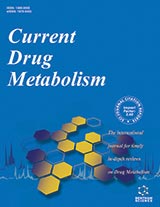Abstract
Cytochrome P450 (CYP) 2D6 is one of the most important drug metabolizing enzymes and the rationalization and prediction of potential CYP2D6 substrates is therefore advantageous in the discovery and development of new drugs. Experimentally, the active site of CYP2D6 can be probed by site directed mutagenesis studies. Such studies can be designed from structural models of enzyme-substrate complexes. Modeling approaches can subsequently be used to rationalize the observed effect of mutations on metabolism and inhibition. The current paper will present the construction, refinement and validation of the CYP2D6 homology model used in our laboratory for the prediction and rationalisation of CYP2D6 substrate metabolism and CYP2D6-ligand interactions. The model could explain reported site-directed mutagenesis data (for example, mutation of E216 and D301). Furthermore, based on the model, new CYP2D6 mutants were constructed and studied in our lab, and also for these mutants a rationalization of experimentally observed characteristics could be achieved (I106E, F120A, T309V, F483A). CYP2D6-substrate interaction fingerprint analysis of docked substrates in our homology model suggests that several other active site residues are probably interacting with ligands as well, opening the way for further mutagenesis studies. Our homology model was found to agree with most of the details of the recently solved substrate-free CYP2D6 crystal structure [Rowland et al. J. Biol. Chem. 2006, 281, 7614-7622]. Structural differences between the homology model and crystal structure were the same differences observed between substrate-free and substrate-bound structures of other CYPs, suggesting that these conformational changes are required upon substrate binding. The CYP2D6 crystal structure further validates our homology modeling approach and shows that computational chemistry is a useful and valuable tool to provide models for substrate-bound complexes of CYPs which give insight into CYP-ligand interactions. This information is essential for successful pre-experimental virtual screening, as well as accurate hypothesis generation for in vitro studies in drug discovery and development.
Keywords: Homology modeling, site-directed mutagenesis, cytochrome P450, CYP2D6, protein-ligand interaction
Current Drug Metabolism
Title: Molecular Modeling-Guided Site-Directed Mutagenesis of Cytochrome P450 2D6
Volume: 8 Issue: 1
Author(s): Chris de Graaf, Chris Oostenbrink, Peter H. J. Keizers, Barbara M. A. van Vugt-Lussenburg, Robert A. B. van Waterschoot, Richard A. Tschirret-Guth, Jan N. M. Commandeur and Nico P. E. Vermeulen
Affiliation:
Keywords: Homology modeling, site-directed mutagenesis, cytochrome P450, CYP2D6, protein-ligand interaction
Abstract: Cytochrome P450 (CYP) 2D6 is one of the most important drug metabolizing enzymes and the rationalization and prediction of potential CYP2D6 substrates is therefore advantageous in the discovery and development of new drugs. Experimentally, the active site of CYP2D6 can be probed by site directed mutagenesis studies. Such studies can be designed from structural models of enzyme-substrate complexes. Modeling approaches can subsequently be used to rationalize the observed effect of mutations on metabolism and inhibition. The current paper will present the construction, refinement and validation of the CYP2D6 homology model used in our laboratory for the prediction and rationalisation of CYP2D6 substrate metabolism and CYP2D6-ligand interactions. The model could explain reported site-directed mutagenesis data (for example, mutation of E216 and D301). Furthermore, based on the model, new CYP2D6 mutants were constructed and studied in our lab, and also for these mutants a rationalization of experimentally observed characteristics could be achieved (I106E, F120A, T309V, F483A). CYP2D6-substrate interaction fingerprint analysis of docked substrates in our homology model suggests that several other active site residues are probably interacting with ligands as well, opening the way for further mutagenesis studies. Our homology model was found to agree with most of the details of the recently solved substrate-free CYP2D6 crystal structure [Rowland et al. J. Biol. Chem. 2006, 281, 7614-7622]. Structural differences between the homology model and crystal structure were the same differences observed between substrate-free and substrate-bound structures of other CYPs, suggesting that these conformational changes are required upon substrate binding. The CYP2D6 crystal structure further validates our homology modeling approach and shows that computational chemistry is a useful and valuable tool to provide models for substrate-bound complexes of CYPs which give insight into CYP-ligand interactions. This information is essential for successful pre-experimental virtual screening, as well as accurate hypothesis generation for in vitro studies in drug discovery and development.
Export Options
About this article
Cite this article as:
de Graaf Chris, Oostenbrink Chris, J. Keizers H. Peter, A. van Vugt-Lussenburg M. Barbara, B. van Waterschoot A. Robert, Tschirret-Guth A. Richard, M. Commandeur N. Jan and E. Vermeulen P. Nico, Molecular Modeling-Guided Site-Directed Mutagenesis of Cytochrome P450 2D6, Current Drug Metabolism 2007; 8 (1) . https://dx.doi.org/10.2174/138920007779315062
| DOI https://dx.doi.org/10.2174/138920007779315062 |
Print ISSN 1389-2002 |
| Publisher Name Bentham Science Publisher |
Online ISSN 1875-5453 |
 30
30
- Author Guidelines
- Bentham Author Support Services (BASS)
- Graphical Abstracts
- Fabricating and Stating False Information
- Research Misconduct
- Post Publication Discussions and Corrections
- Publishing Ethics and Rectitude
- Increase Visibility of Your Article
- Archiving Policies
- Peer Review Workflow
- Order Your Article Before Print
- Promote Your Article
- Manuscript Transfer Facility
- Editorial Policies
- Allegations from Whistleblowers
- Announcements


























